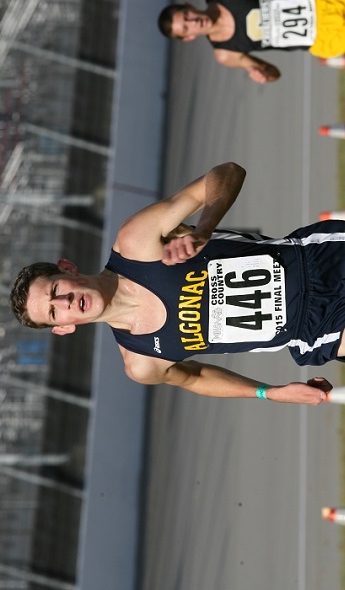
Performance: Algonac's Morgan Beadlescomb
May 17, 2016
 Morgan Beadlescomb
Morgan Beadlescomb
Algonac senior – Track & Field
Beadlescomb will finish his high school career next month all over the Algonac record books and MHSAA champions lists as well. He won the Lower Peninsula Division 2 cross country championship each of the last two seasons and also won the LP Division 2 track title in the 1,600 last spring. His time in the 1,600 that day set a school record of 4:13.58, and he added his school’s 3,200 record of 9:03.68 in finishing first at the prestigious Saline Golden Triangle Invitational on May 6, earning him the Michigan National Guard Performance of the Week for May 2-8.
The 9:03 was thought to be the fastest time in the state in the 3,200 this season – but was matched by a 9:03 the same night by Corunna’s Noah Jacobs at the Cavalier Classic True Team Invitational. Beadlescomb finished fifth in the 3,200 at last year’s MHSAA LP Division 2 Final, as Jacobs won the race, and he intends to run against Jacobs in both the 1,600 and 3,200 at this season’s Final, June 4 at Zeeland.
 Beadlescomb also has run the 400 in 51.8 seconds this season and the 800 in 157.7; that 800 time would’ve finished seventh in LP Division 2 in 2015. His improvement during high school was impressive, especially in cross country; Beadlescomb finished 138th in LP Division 2 as a freshman before jumping to 12th as a sophomore and then winning his final two seasons. Boasting a 3.3 grade-point average, Beadlescomb will study and run next at Michigan State University, where he’ll major in mechanical engineering. He also recently was one of 12 finalists statewide for the Detroit Athletic Club’s annual Michigan High School Athlete of the Year awards, which are given to one female and male to recognize both athletic and academic achievement.
Beadlescomb also has run the 400 in 51.8 seconds this season and the 800 in 157.7; that 800 time would’ve finished seventh in LP Division 2 in 2015. His improvement during high school was impressive, especially in cross country; Beadlescomb finished 138th in LP Division 2 as a freshman before jumping to 12th as a sophomore and then winning his final two seasons. Boasting a 3.3 grade-point average, Beadlescomb will study and run next at Michigan State University, where he’ll major in mechanical engineering. He also recently was one of 12 finalists statewide for the Detroit Athletic Club’s annual Michigan High School Athlete of the Year awards, which are given to one female and male to recognize both athletic and academic achievement.
Coach Mark Simms said: “Morgan has a tremendous drive and work ethic. He does not accept finishing second and drives to be the best he can be. Morgan is the most talented track athlete that I have been associated with in my 22-year career. Morgan has left his mark here at Algonac High School. His track records will probably stand for years to come.”
Performance Point: “I remember I took the race out too fast, and that made the entire race difficult. It was hard to hang in there the whole time. But my coaches were there the whole time cheering me on and motivating me, some kids from Michigan State were there watching old teammates and cheering me on, and my parents were too. (The atmosphere) helped motivate me while I was running, for sure. There never really was a silent part of the track.”
Leaving a legacy: “I’m hoping people will remember my work ethic. I worked hard to get where I am. I’m not a naturally talented athlete, and I’ve not always been at the front of the pack … so I hope people will remember me for that.”
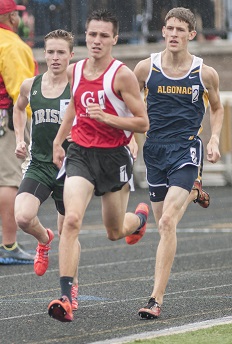 Finish strong: “I’m hoping to place top in the nation in the mile or 2-mile; I’m leaning more toward the 2-mile. I’ve got more national goals than I have had in the past. The state meet is going to be difficult because I’m going for the mile/2-mile double. In the mile (1,600) there are two kids under 4:20, but if I play it smart I think I can win that. The 2-mile (3,200) is really difficult (because of) Noah Jacobs. He’s so smart, he knows how to run, he doesn’t get too excited. It’s a battle against him, but I always look forward to it.”
Finish strong: “I’m hoping to place top in the nation in the mile or 2-mile; I’m leaning more toward the 2-mile. I’ve got more national goals than I have had in the past. The state meet is going to be difficult because I’m going for the mile/2-mile double. In the mile (1,600) there are two kids under 4:20, but if I play it smart I think I can win that. The 2-mile (3,200) is really difficult (because of) Noah Jacobs. He’s so smart, he knows how to run, he doesn’t get too excited. It’s a battle against him, but I always look forward to it.”
Racing Jacobs: “It’s nice because we’re not at each other’s throats. We like each other, we’re friends, and it’s nice to race against him. It’s a healthy competition. Every sport, I think most kids are like that, especially in high school. Most sports, I've found, kids get along with the other athletes, especially when they get more toward the top, the elite teams. It’s nice to share experiences. We learn from each other.”
Morgan in motion: “I’ve always loved working on moving things. I grew up racing motocross, and I love not only riding but working on the motorcycles. I love learning about cars. If it has a motor, it’s my thing.”
– Geoff Kimmerly, Second Half editor
Every week during the 2015-16 school year, Second Half and the Michigan National Guard will recognize a “Performance of the Week" from among the MHSAA's 750 member high schools.
The Michigan Army National Guard provides trained and ready forces in support of the National Military Strategy, and responds as needed to state, local, and regional emergencies to ensure peace, order, and public safety. The Guard adds value to our communities through continuous interaction. National Guard soldiers are part of the local community. Guardsmen typically train one weekend per month and two weeks in the summer. This training maintains readiness when needed, be it either to defend our nation's freedom, or protecting lives and property of Michigan citizens during a local natural disaster.
Previous 2015-16 honorees
May 4: Abby Krzywiecki, Farmington Hills Mercy softball - Read
April 27: Mike Mokma, Holland Christian baseball - Read
April 20: Abby Divozzo, Cadillac girls soccer - Read
March 30: Cassius Winston, Detroit U-D Jesuit boys basketball - Read
March 23: Kierra Fletcher, Warren Cousino girls basketball - Read
March 16: Jacob Montague, Grosse Pointe South swimming & diving - Read
March 9: Kyle Tuttle, St. Charles boys bowling - Read
March 2: Brittney Schnicke, Caledonia girls bowling - Read
Feb. 24: Kamari Newman, Detroit East English boys basketball - Read
Feb. 17: Jason Whitens, Powers North Central boys basketball - Read
Feb. 10: Rachel Hogan, Grand Ledge gymnastics - Read
Feb. 3: Nehemiah Mork, Midland Dow swimming & diving - Read
Jan. 27: Mardrekia Cook, Muskegon girls basketball - Read
Jan. 20: Sage Castillo, Hartland wrestling - Read
Jan. 13: Rob Zofchak, Dexter swimming & diving - Read
Jan. 6: Tyler Deming, Caro wrestling – Read
Dec. 15: Jordan Weber, East Jordan boys basketball – Read
Dec. 8: Kaitlyn Geers, Kent City girls basketball – Read
PHOTOS: (Top) Algonac's Morgan Beadlescomb leads during the final stretch of the Division 2 Cross Country Final last fall at Michigan International Speedway. (Middle) Beadlescomb (far right) prepares to make his move on the way to winning the 1,600 at last season's MHSAA LP Division 2 Track & Field Final. (Photos by Ike Lea and Carter Sherline, RunMichigan.com.)
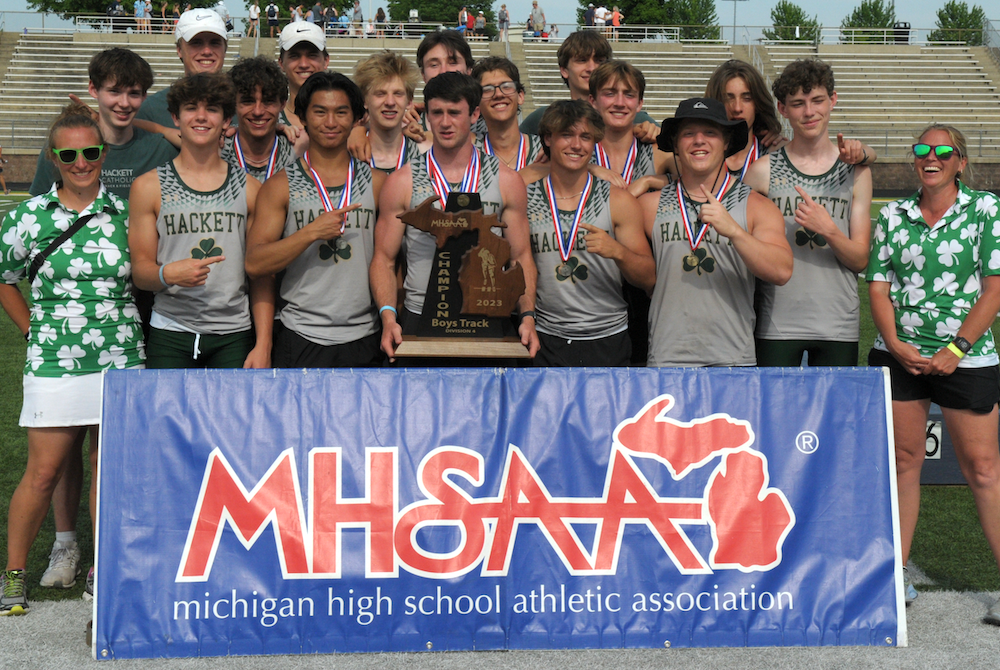
Thrower Claims Lone Individual Title to Lead Hackett to Team 3-Peat
By
Tom Lang
Special for MHSAA.com
June 3, 2023
Kalamazoo Hackett Catholic Prep just keeps winning and winning.
This time the Irish took home their fourth title in the last five Lower Peninsula Division 4 Track & Field Finals, on Saturday at Hudsonville.
Hackett’s only individual title was taken by discus winner Nathan Buchmann, a senior, who was fine knowing he was the shortest in stature among all the sizable competitors.
“In the offseason after football I worked out every day, working towards this goal,” he said after getting his medal. “I would say this takes 80 percent technique and 20 percent strength to throw the discus. So, length can help but if you have good technique and are really strong, that will play into it.
“I think we are very balanced throughout the meet today,” he said about teammates that scored points in finishes other than first place. “We have 13 guys here today, and we have people in a lot of the races. But I do not run; I have too short of legs to be a fast runner,” he said with a chuckle.
Buchmann had to work through a hip injury to compete this spring.
“I think the setbacks are what make you strong,” he said. “You can either give up through the setbacks or push forward and become better.”
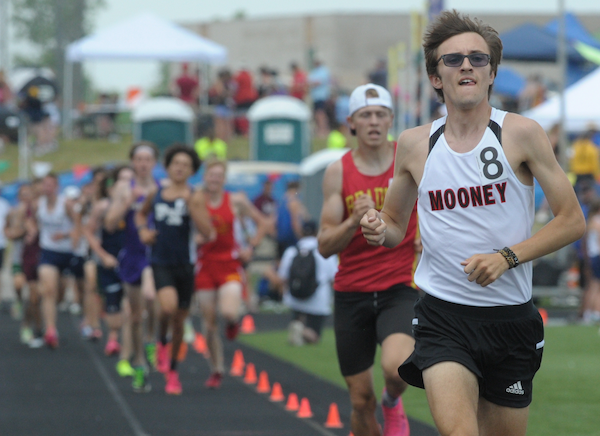 Coach Charissa Dean agreed.
Coach Charissa Dean agreed.
“The kids have big hearts,” she said after all the points were totaled and the Irish were on top once again, with 53. “They worked hard. They had a lot of potential when we started the season. And we had a lot of drive to put in the work, and we are happy the results came out the way they did.”
Reading was runner-up at 47 points, followed by Wyoming Potter’s House Christian with 42, then Fowler and Flint Beecher each with 37 points.
Senior Lezawe “Moses” Osterink, of Potter’s House Christian, placed second in 1,600 but took the 3,200 title as defending champ of both. He dominated the latter by lapping the field with a final lap kick that resembled more of a superhero speedster.
“Nobody really took it out that hard at the start,” he said. “There was a freshman (Marek Butkiewicz of Hackett) that tried to get the pace going quick, but me and Dakota (Dykhuis of Montabella) just kind of sat back and gradually pulled him through.
“We took it gradually, and I was just relying that I could kick.”
Kick did he ever. The trio were neck and neck the majority of the race in a grouping ahead of the pack.
“With 400 to go I just tried to go all out,” Osterink said. “I had a lot more left than I thought and I was pleased with the win. Not really the time, but that doesn’t matter, especially this hot out.”
The overall meet was in the low 90s/high 80s heat and searing sun all day. So, race officials allowed the unique opportunity for coaches to spray the runners with water and give them water bottles.
“It was very weird because I’ve never taken water to drink while I’m running, so I didn’t know how that would feel,” Osterink said. “And they were spraying us and hitting us in the face. It was kind of fun.”
Junior Tyler Lenn of Marine City Cardinal Mooney defeated Osterink at his own game in the 1,600.
“I’m feeling great,” Lenn said after grabbing the medal. “I said to a newspaper after one of my races (during the season) I was right where I wanted to be. This has been a long rebuilding process for me since an injury back in the fall, and I set a pretty high goal the day the injury happened. I was telling myself I needed to fulfill what I said I would do at the beginning of last cross country season. And that is what I did today.”
Lenn suffered an ankle sprain from a misstep that turned worse because he kept running through the season on it.
“Coming back from that was pretty tough, but I wouldn’t have it any other way,” he said. 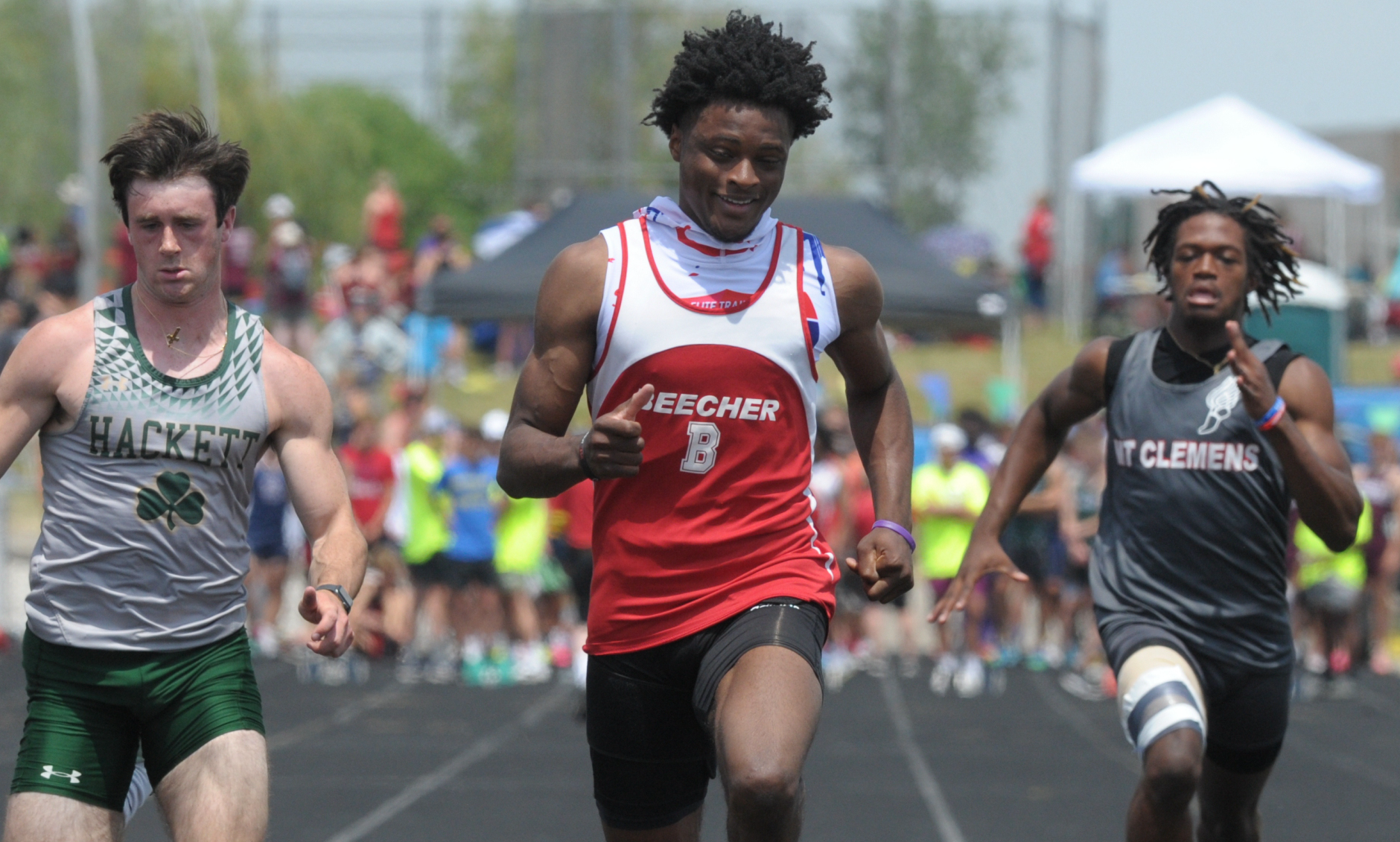 “Perseverance; I said from the beginning what I was going to do. I kept my eye on that target, and no matter the circumstances life threw at me, that I was going to make it happen and I am a man of my word.”
“Perseverance; I said from the beginning what I was going to do. I kept my eye on that target, and no matter the circumstances life threw at me, that I was going to make it happen and I am a man of my word.”
Jaylin Townsend, a senior from Flint Beecher, dominated the short races. He won the 100 dash (10.67) and 200 dash at 22 seconds flat. It was his third 100 win at a Finals.
“I put in a lot of work; I had to three-peat,” he said after the 100. “There’s a lot of great competition here, so I knew I had to come out and run my best.”
Concord in the 400 (43.72), Buckley in the 800 (1:30.76) and 1,600 (3:29.13) and Potter’s House in the 3,200 (8:14.18) were relay champs Saturday. Reading’s Tayshawn Bester won the 110 hurdles (15.13), and Athens’ Landen Bennett won the 300 (39.85). Caseville’s Nathan Feltner won the 400 (50.76), and Vestaburg’s Owen Patton claimed the 800 (1:55.11).
Fruitport Calvary Christian’s Bradley Richards won the high jump (6-10), and Peck’s Alex Affer won the long jump (23-4). McBain Northern Michigan Christian’s Isaac Bowden was first in pole vault (13-0), and Brown City’s Kyle Affer won shot put (49-2).
PHOTOS (Top) Kalamazoo Hackett Catholic Prep celebrates its third-straight LPD4 title Saturday. (Middle) Cardinal Mooney's Tyler Lenn, far right, sets the pace in the 1,600. (Below) Flint Beecher's Jaylin Townsend, middle, crosses the finish first for one of his two sprint championships. (Photos by Ken Swart/RunMichigan.com.)

